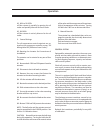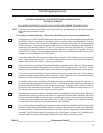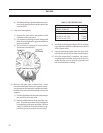
49
A) Disconnect the motor drive coupling from the
compressor input shaft.
B) Disconnect all gas and oil piping which is at-
tached to the compressor. When removing the
suction strainer on gas compression units, the
suction line should be supported to prevent it
from sagging.
C) Replace oil drain in compressor housing and dis-
charge manifold after oil has stopped draining.
D) Remove all electrical connections to the com-
pressor.
E) On compressors with mounting feet, loosen and
remove bolts holding the compressor to the
base.
Keep compressor alignment shims together and
mark the locations with a permanent marker.
F) On compressors with C-flange the motor/C-
ange/compressor assembly must be supported
with a chain fall or other lifting device before the
bolts holding the compressor to the C-ange
adapter can be removed.
G) Install appropriate lifting eye into the threaded
hole on the top of the compressor.
Verify unit is properly secured to avoid compressor
from falling. Re-verify all piping and electrical are
properly disconnected prior to lifting unit.
H) Lift compressor from the base, verify the amount
of room needed for clearance and weight of
the bare compressor when the compressor is
removed from the unit.
GENERAL COMMENTS
When working on the compressor, care must be taken
to ensure that contaminants (i.e. water from melting
ice, dirt and dust) do not enter the compressor while
it is being serviced. It is essential that all dust, oil or
ice that has accumulated on the outside of the com-
pressor be removed before servicing the compressor.
When servicing the compressor, all gaskets, O-rings,
roll pins and lock washers must be replaced when
reassembling the compressor.
PREPARATION OF UNIT FOR SERVICING
A) Shut down the unit, open the electrical discon-
nect switch and pull the fuses for the compressor
motor to prevent the unit from starting. Put a
lock on the disconnect switch and tag the switch
to indicate that maintenance is being performed.
B) Isolate the unit by manually closing the discharge
Stop valve. Allow the unit to equalize to suction
pressure before closing the Suction Bypass. After
the unit has equalized to suction pressure and
suction valve closed, use an acceptable means to
depressurize the unit that complies with all Local,
State and Federal Ordinances.
C) Remove drain plugs from the bottom of com-
pressor housing and the discharge manifold On
units equipped with Suction Oil Injection (SOI)
manually open the SOI solenoid valve below the
compressor. Drain the oil into appropriate con-
tainers.
REMOVAL OF COMPRESSOR FROM THE UNIT
After preparing the unit for service, the following steps
should be followed when removing the compressor
from the unit:
Service


















